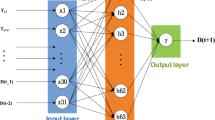Abstract
This paper explored the potential of Backpropagation Neural Network (BNN) and M5 model tree based regression approach to estimate the mean annual flood. Data used in this study were taken from an earlier study by Swamee et al. (J Water Resour Plan Manage 121:403–407, 1995) for 93 Indian catchments spread over the entire country. The relationship proposed by Swamee et al. (J Water Resour Plan Manage 121:403–407, 1995) was compared with the predictive accuracy of a BNN and M5 model tree approach. The data were analyzed using a tenfold cross-validation. Comparison of the results showed that predictions with the backpropagation neural network fell within a scatter line of ±30% with a correlation coefficient of 0.975. Furthermore, predictions with the M5 model tree fell well within a scatter line of ±15% with a correlation coefficient as high as 0.994. The results also showed that predicted values with neural network and M5 model tree were within about 1.25 times the actual values. However, the predicted values obtained using the Swamee et al. (J Water Resour Plan Manage 121:403–407, 1995) approach fell much beyond the scatter line of ±50% and the predicted mean annual flood values were sometimes as high as eight times the actual values. The correlation coefficient with this approach was 0.897. The results from this study suggest that backpropagation neural network and M5 model tree-based modeling approaches are superior in accuracy to the model proposed by Swamee et al. (J Water Resour Plan Manage 121:403–407, 1995). This study also suggests that M5 model trees, being analogous to piecewise linear functions, have certain advantages over neural networks as they offer more insight into the generated model, are acceptable to decision makers and are very efficient in training, and always converge.
Similar content being viewed by others
References
Altunkaynak A (2007) Forecasting surface water level fluctuations of Lake Van by artificial neural networks. Water Resour Manag 21(2):399–408
Bhattacharya B, Solomatine DP (2005) Neural networks and M5 model trees in modelling water level–discharge relationship. Neurocomputing 63:381–396
Bishop CM (1995) Neural networks for pattern recognition. Clarendon, Oxford
Cigizoglu HK, Alp M (2006) Generalized regression neural network in modelling river sediment yield. Adv Eng Softw 37(2):63–68
Dawson CW, Wilby R (1998) An artificial neural network approach to rainfall–runoff modeling. Hydrol Sci J 43(1):47–66
Govindaraju RS (2000) Chairman, ASCE task committee on application of artificial neural networks in hydrology, artificial neural network in hydrology. ASCE J Hydrol Eng 5(2):115–137
Haykin S (1999) Neural networks: a comprehensive foundation, 2nd edn. Prentice-Hall, Upper Saddle River
Hong WC, Pai PF (2007) Potential assessment of the support vector regression technique in rainfall forecasting. Water Resour Manag 21(2):495–513
Lee KT, Hung WC, Meng CC (2008) Deterministic insight into ANN model performance for storm runoff simulation. Water Resour Manag 22(1):67–82
Nourani V, Komasi M, Mano A (2009) A multivariate ANN-wavelet approach for rainfall–runoff modeling. Water Resour Manag 23(14):2877–2894
Pal M, Goel A (2007) Estimation of discharge and end depth in trapezoidal channel by support vector machines. Water Resour Manag 21(10):1763–1780
Quinlan JR (1992) Learning with continuous classes. In: Adams A, Sterling L (eds) Proceedings of the 5th Australian joint conference on artificial intelligence. World Scientific, Singapore, pp 343–348
Rumelhart DE, Hinton GE, Williams RJ (1996) Learning internal representation by error propagation. Parallel distributed processing: explorations in the microstructure of cognition, vol 1: foundations. MIT, Cambridge, pp 318–362
Sakhare S, Deo MC (2009) Derivation of wave spectrum using data driven methods. Mar Struct 22(3):594–609
Schalkoff RJ (1992) Pattern recognition: statistical, structural and neural approaches. Wiley, New York
Shrestha DL, Solomatine DP (2006) Machine learning approaches for estimation of prediction interval for the model output. Neural Netw 19(2):225–235
Singh KK, Kumar S (2007) Extension of stream flow series using artificial neural networks. ISH J Hydraul Eng India 13(3):55–65
Singh KK, Pal M, Ojha CSP, Singh VP (2008) Estimation of removal efficiency for settling basins using neural networks and support vector machines. J Hydrol Eng 13(3):146–155
Sohail A, Watanabe K, Takeuchi S (2008) Runoff analysis for a small watershed of Tono Area Japan by back propagation artificial neural network with seasonal data. Water Resour Manag 22(1):1–22
Solomatine DP, Dulal KN (2003) Model tree as an alternative to neural network in rainfall–runoff modeling. Hydrol Sci J 48(3):399–412
Solomatine DP, Xue Y (2004) M5 model trees and neural networks: application to flood forecasting in the upper reach of the Huai River in China. J Hydrol Eng 9(6):1–10
Swamee PK, Ojha CSP, Abbas A (1995) Mean annual flood estimation. J Water Resour Plan Manage 121:403–407
Wilde PD (1997) Neural network models: theory and projects, 2nd edn. Springer, London
Witten IH, Frank E (2005) Data mining: practical machine learning tools and techniques, 2nd edn. Morgan Kaufmann, San Francisco
Author information
Authors and Affiliations
Corresponding author
Rights and permissions
About this article
Cite this article
Singh, K.K., Pal, M. & Singh, V.P. Estimation of Mean Annual Flood in Indian Catchments Using Backpropagation Neural Network and M5 Model Tree. Water Resour Manage 24, 2007–2019 (2010). https://doi.org/10.1007/s11269-009-9535-x
Received:
Accepted:
Published:
Issue Date:
DOI: https://doi.org/10.1007/s11269-009-9535-x




